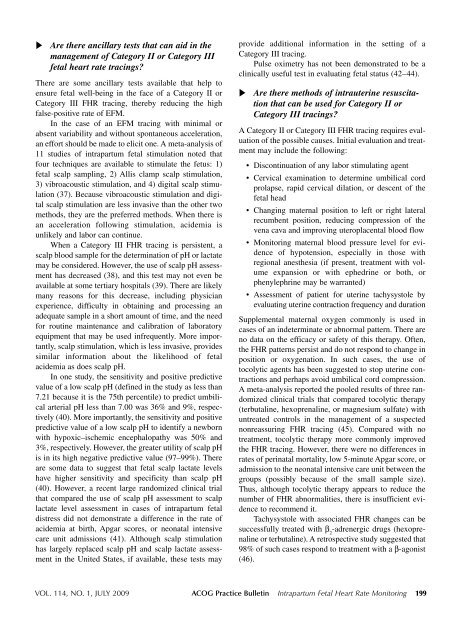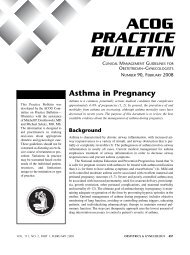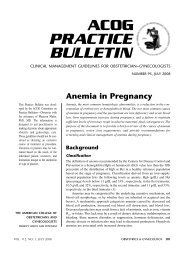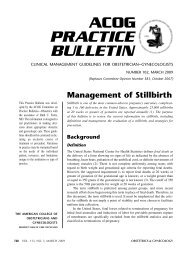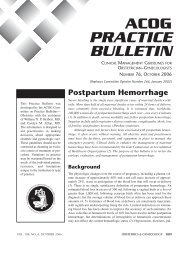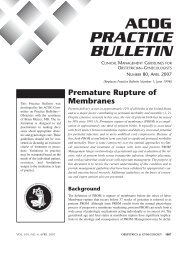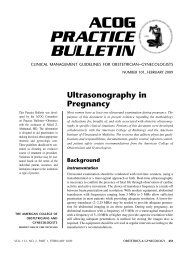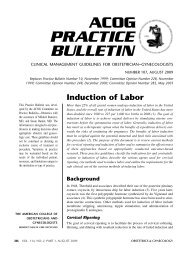ACOG Practice Bulletin: Intrapartum Fetal Heart rate Monitoring
ACOG Practice Bulletin: Intrapartum Fetal Heart rate Monitoring
ACOG Practice Bulletin: Intrapartum Fetal Heart rate Monitoring
- No tags were found...
Create successful ePaper yourself
Turn your PDF publications into a flip-book with our unique Google optimized e-Paper software.
Are there ancillary tests that can aid in themanagement of Category II or Category IIIfetal heart <strong>rate</strong> tracings?There are some ancillary tests available that help toensure fetal well-being in the face of a Category II orCategory III FHR tracing, thereby reducing the highfalse-positive <strong>rate</strong> of EFM.In the case of an EFM tracing with minimal orabsent variability and without spontaneous acceleration,an effort should be made to elicit one. A meta-analysis of11 studies of intrapartum fetal stimulation noted thatfour techniques are available to stimulate the fetus: 1)fetal scalp sampling, 2) Allis clamp scalp stimulation,3) vibroacoustic stimulation, and 4) digital scalp stimulation(37). Because vibroacoustic stimulation and digitalscalp stimulation are less invasive than the other twomethods, they are the preferred methods. When there isan acceleration following stimulation, acidemia isunlikely and labor can continue.When a Category III FHR tracing is persistent, ascalp blood sample for the determination of pH or lactatemay be considered. However, the use of scalp pH assessmenthas decreased (38), and this test may not even beavailable at some tertiary hospitals (39). There are likelymany reasons for this decrease, including physicianexperience, difficulty in obtaining and processing anadequate sample in a short amount of time, and the needfor routine maintenance and calibration of laboratoryequipment that may be used infrequently. More importantly,scalp stimulation, which is less invasive, providessimilar information about the likelihood of fetalacidemia as does scalp pH.In one study, the sensitivity and positive predictivevalue of a low scalp pH (defined in the study as less than7.21 because it is the 75th percentile) to predict umbilicalarterial pH less than 7.00 was 36% and 9%, respectively(40). More importantly, the sensitivity and positivepredictive value of a low scalp pH to identify a newbornwith hypoxic–ischemic encephalopathy was 50% and3%, respectively. However, the greater utility of scalp pHis in its high negative predictive value (97–99%). Thereare some data to suggest that fetal scalp lactate levelshave higher sensitivity and specificity than scalp pH(40). However, a recent large randomized clinical trialthat compared the use of scalp pH assessment to scalplactate level assessment in cases of intrapartum fetaldistress did not demonst<strong>rate</strong> a difference in the <strong>rate</strong> ofacidemia at birth, Apgar scores, or neonatal intensivecare unit admissions (41). Although scalp stimulationhas largely replaced scalp pH and scalp lactate assessmentin the United States, if available, these tests mayprovide additional information in the setting of aCategory III tracing.Pulse oximetry has not been demonst<strong>rate</strong>d to be aclinically useful test in evaluating fetal status (42–44).Are there methods of intrauterine resuscitationthat can be used for Category II orCategory III tracings?A Category II or Category III FHR tracing requires evaluationof the possible causes. Initial evaluation and treatmentmay include the following:• Discontinuation of any labor stimulating agent• Cervical examination to determine umbilical cordprolapse, rapid cervical dilation, or descent of thefetal head• Changing maternal position to left or right lateralrecumbent position, reducing compression of thevena cava and improving uteroplacental blood flow• <strong>Monitoring</strong> maternal blood pressure level for evidenceof hypotension, especially in those withregional anesthesia (if present, treatment with volumeexpansion or with ephedrine or both, orphenylephrine may be warranted)• Assessment of patient for uterine tachysystole byevaluating uterine contraction frequency and durationSupplemental maternal oxygen commonly is used incases of an indeterminate or abnormal pattern. There areno data on the efficacy or safety of this therapy. Often,the FHR patterns persist and do not respond to change inposition or oxygenation. In such cases, the use oftocolytic agents has been suggested to stop uterine contractionsand perhaps avoid umbilical cord compression.A meta-analysis reported the pooled results of three randomizedclinical trials that compared tocolytic therapy(terbutaline, hexoprenaline, or magnesium sulfate) withuntreated controls in the management of a suspectednonreassuring FHR tracing (45). Compared with notreatment, tocolytic therapy more commonly improvedthe FHR tracing. However, there were no differences in<strong>rate</strong>s of perinatal mortality, low 5-minute Apgar score, oradmission to the neonatal intensive care unit between thegroups (possibly because of the small sample size).Thus, although tocolytic therapy appears to reduce thenumber of FHR abnormalities, there is insufficient evidenceto recommend it.Tachysystole with associated FHR changes can besuccessfully treated with β 2-adrenergic drugs (hexoprenalineor terbutaline). A retrospective study suggested that98% of such cases respond to treatment with a β-agonist(46).VOL. 114, NO. 1, JULY 2009 <strong>ACOG</strong> <strong>Practice</strong> <strong>Bulletin</strong> <strong>Intrapartum</strong> <strong>Fetal</strong> <strong>Heart</strong> Rate <strong>Monitoring</strong> 199


